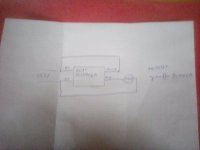My boiler Aquastat is set to a High Temp limit of 180 F. Some folks say you get better efficiency by running at a slightly higher temp, like 190 F. What does your experience tell you?
https://inspectapedia.com/heat/Aquastat_Settings.php
___ "Generally a heating boiler is more efficient if we operate it at a higher temperature."
The full quote from that link is:
"
Generally a heating boiler is more efficient if we operate it at a higher temperature.
The thermal conductivity of heating water inside of finned copper tubing baseboards or through radiator surfaces is exponentially greater at higher temperatures.
In other words, hotter water actually transfers heat into the occupied space more efficiently than cooler water."
What they are a calling "efficient" isn't fuel-efficiency, but rather it delivers heat rate coming off the heat emitters. They are only saying that higher temp means the heat rate is higher (DUH!), and says
nothing about fuel-economy or comfort.
Higher boiler temperatures are the opposite of both higher
comfort, and higher
fuel efficiency. For comfort the LOWEST water temperature and SLOWEST heat rate that still satisfies the thermostat is the most effective since it delivers steadier longer on-cycles. That also improves the overall system, so long as there is enough radiation to suppress short-cycling at the lower water temperature.
The raw steady state combustion efficiency will actually FALL (slightly) at a higher temperature. At the same time the
standby losses from the boiler to the boiler room will increase as well. A lower average water temperature will increase the average combustion efficiency and reduce standby losses, for an overall net increase in system efficiency, provided the boiler isn't short cycling. The hit in combustion efficiency is small when going from 180F to 190F about 0.1-0.2% at most.
The biggest efficiency problems with cast iron boiler systems are short burn time (short cycle) and low duty cycle (= more standby time, more standby loss.) There isn't much improvement to be made on duty cycle with fixed rate non-modulating burners, but the burn times can be improved by maximizing the differential between high and low limit settings.
The greater the temperature difference the system has to slew through, the longer it takes to heat up the system's thermal mass. For the average efficiency to hit closed the steady state (continuous burn) combustion efficiency usually takes ~10 minutes per burn or more, but for most boilers there's only about a 1% hit if the burns are only 5 minutes. But with burn times significantly shorter than that the average efficiency starts to fall off a cliff.
The relatively safe
low limit for most oil boilers is 140F for oil boilers, 130F for most gas burners. These low limits are necessary to limit the amount of acidic flue condensation, and to avoid excessive corrosion on the fire side of the heat exchanger plates. With
condensing gas burners this isn't a problem- condensation reaps significant efficiency improvements when the entering water temp at the boiler drops further below ~125F. But cast iron can't take the acidity and can be destroyed in one heating season if allowed to chronically condense, which can be an issue if there is too much radiation, or too much thermal mass in the radiation. There are plumbing solutions to protect against low-temp entering the cast iron boiler, but unless you have that issue I won't go into it here.
Replacing aquatstats with heat purging economizer controls such as the Beckett 7512 HeatManager, Beckett AquaSmart, IntelliCon HW+ 3250, HydroStat 3200/3250-Plus, etc. will increase burn times by "exercising" the thermal mass, suppressing the burner on new calls of heat until it hits the low limit, pre-purging heat from the boiler into the zone. Some of them it "learn" the system's behavior and cuts the burner a bit before the thermostat is satisfied, finishing the call for heat with the heat already in the boiler, lowering it's average temperature, which lowers the standby and distribution losses. When the systems are significantly oversized (2-3x or more) with very low average duty cycle this reduction in idling loss has a dramatic effect on the as-used efficiency and fuel use. Most new cast iron boilers now come fitted with (or can be ordered with) this type of control already installed.
So before screwing around with aquastat controls, measure the burn times. If you have a heating history on the place, run a fuel-use based heat load calculation (wintertime fuel use only) and compare it to the BTU output (the raw DOE BTU numbers, not the net-water IBR output) on the boiler's nameplate. AFUE measurements assume a 1.7x oversize factor, and are usually pretty close to the steady-state efficiency of the boiler. But per ASHRAE recommendations the optimal oversize factor for both comfort & efficiency is 1.4x- which is enough to cover Polar Vortex disturbance cold snaps well below the
99% outside design temp, while still maintaining a high duty cycle during normal cold weather.
The amount of radiation also affects the optimal boiler size and may affect the near-boiler plumbing if there is so much radiation that the return temps are too cool. But in general the smallest boiler that actually covers the peak load is the most comfortable, since it's delivering steadier heat and long burns, not cycling on/off giving you the hot flash followed by the extended chill when it's truly cold outside.


